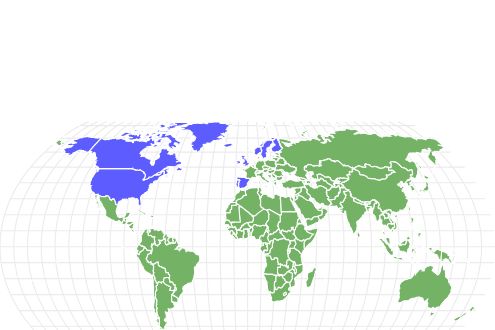Harbor Porpoise
Surprisingly, not a dolphin!
Advertisement
Harbor Porpoise Scientific Classification
Read our Complete Guide to Classification of Animals.
Harbor Porpoise Conservation Status
Harbor Porpoise Facts
- Prey
- Squid, Fish, Octopus, and Crustaceans
- Name Of Young
- Pups, Calves
- Group Behavior
- Social
- Estimated Population Size
- 840,000
- Biggest Threat
- Commercial fishing nets, water pollution, and noise pollution
- Most Distinctive Feature
- A triangular dorsal fin, rounded head
- Other Name(s)
- Puffin Pig
- Gestation Period
- 10-11 months
- Habitat
- Bays, estuaries, oceans, harbors, fjords, and rivers
- Predators
- Orcas, Large Sharks, and Dolphins
- Diet
- Carnivore
- Average Litter Size
- One
- Lifestyle
- Day and Night
- Common Name
- Porpoise
- Number Of Species
- 7
- Location
- Off the coasts of Alaska, eastern United States, Greenland, western Africa, and western Europe
- Slogan
- Surprisingly, not a dolphin!
Harbor Porpoise Physical Characteristics
- Skin Type
- Hair
- Top Speed
- 34 mph
- Lifespan
- Varies by species
- Weight
- 110-490 lbs.
- Length
- 4’7” – 7’7”
- Age of Sexual Maturity
- 2-8 years
- Age of Weaning
- 7-24 months
View all of the Harbor Porpoise images!
A porpoise can swim as fast as 34 mph!
There are seven species of porpoise and they are often mistaken for dolphins. These mammals live in bays, rivers, and estuaries in many areas of the world. A porpoise can dive more than 600 feet into the depths of the ocean.
5 Unique Porpoise Facts
• Porpoises can live to be 23 years old, depending on their health and potential predators in their area.
• While social, these mammals can usually be seen traveling in pairs or groups (shoals) of three. Although harbor porpoises are known to travel in groups of up to 100!
• They are carnivores that eat mostly fish and crustaceans. It swallows its prey whole and will often alert other porpoises once it finds a food source.
• Porpoises are related to both dolphins and whales. To tell the difference between a porpoise and a dolphin, look at the animal’s nose. Dolphins have beak-like noses while porpoises have shorter noses.
• Porpoises communicate with one another in a series of whistles and clicks.

Scientific Name
Porpoises belong to the Phocoenidae family and the class Mammalia. There are seven subspecies of porpoises. Although similar in appearance to dolphins, porpoises are more closely related to the beluga whale and the narwhal.
The scientific name of a harbor porpoise is Phocoena phocoena. The word ‘Phocoena’ is Latin for ‘pig fish’. A porpoise is sometimes called a puffin’ pig because of the exhaling sound it makes when it reaches the surface of the water after a dive. Some scientists think the noise sounds like a sneeze!
Evolution And History
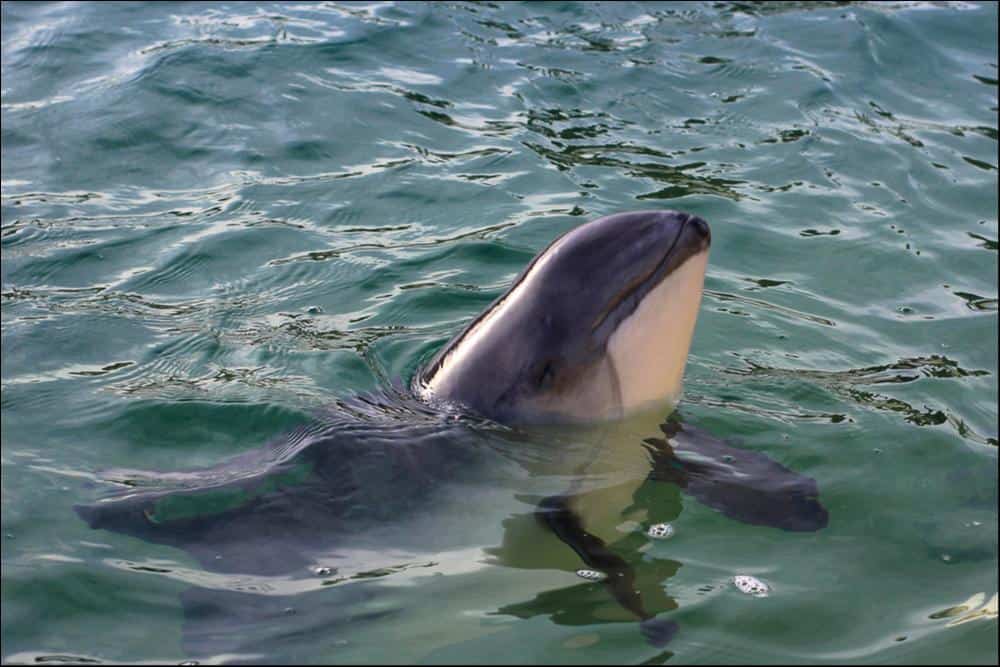
©Elise V/Shutterstock.com
The porpoise, much like dolphins and whales, is a descendant of land-dwelling mammals that first went into the ocean around 50 million years ago. Part of the larger Delphinoidea family, it is believed that they split from their original genus of Monodontidae, to form the current species of Phocoenidae about 15 million years ago, during the Miocone era.
During the Pliocene era, which was 5.4 to 2.4 million years ago, the various species of porpoises began to diverge into the different species we see today due to the intense changes in the environment. It is even suggested that porpoises began in a tropical environment, then moved into temperate areas in both the Northern and Southern Hemispheres.
Types Of Porpoises
While dolphins and porpoises may look similar, they are vastly different and are in a different class of species as well. Dolphins contain 32 different species, while the porpoise has a smaller number of 7. The following are members of the porpoise family:
- Harbor porpoise
- Dall’s porpoise
- Indo-Pacific finless porpoise
- Vaquita – is thought to be the most endangered marine mammal in the world.
- Burmeister’s porpoise
- Spectacled porpoise
- Narrow-ridged finless porpoise
Appearance And Behavior
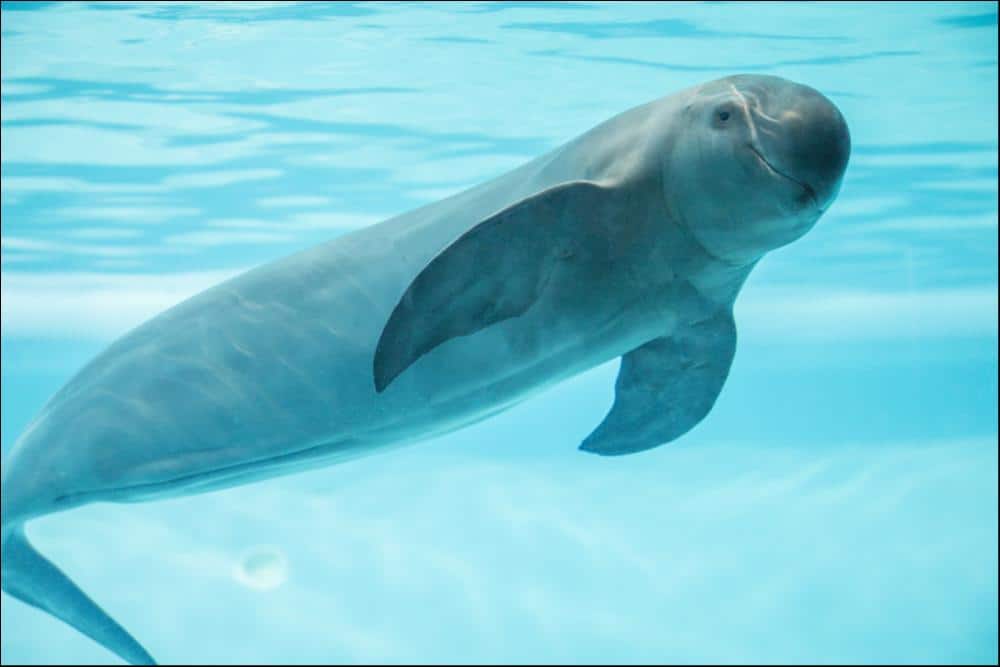
All porpoises have smooth, sleek skin, with darker coloring on their backs than their stomachs.
©Takayuki Ohama/Shutterstock.com
Porpoises vary in color but all have smooth, sleek skin and their backs are darker in color than their stomachs (known as countershading). Most porpoises are a shade of gray on their back and a lighter gray or white on their stomach, however, Burmeister’s porpoise is mostly dark gray or black in color and Dall’s porpoise has a black and white coloring.
Porpoises have strong flippers and teeth with spade-shaped tips – their teeth are actually another way that they differ from dolphins. A porpoise has a rounded head and a triangular-shaped dorsal fin. However, as their name suggests, the finless species of porpoise do not have fins.
Porpoises range from 4.7 to 7.7 feet in length and can weigh between 110 to 490 pounds. Females are usually larger than males. An average porpoise is the length of a full-size mattress. A porpoise of around 200 pounds is equal in weight to half of an adult reindeer. The longest of the seven species, at 7.5 feet, is the Dall’s porpoise
Like many other mammals, porpoises have defensive features that help them evade predators. Their color is one. The back of a porpoise is darker than its stomach, which helps them to blend into their watery environment. Because porpoises are some of the fastest swimmers in the ocean, averaging speeds of up to 34 mph, they can also outrun some predators.
A porpoise doesn’t use its spade-shaped teeth to chew up its prey. Instead, the shape of their teeth helps them to grab fish, squid, octopus, and crustaceans, so they can swallow them whole! These amazing creatures have what are called gum teeth between their spade-shaped teeth. The gum teeth are there to help a porpoise grasp and hold on to a slippery food source like a squid or an octopus. No wonder they call them gum teeth!
Porpoises use echolocation to find prey. Echolocation happens when a porpoise makes a sound that bounces off its prey and echoes back to them. This allows a porpoise to detect the location of prey even when it’s swimming in the dark depths of the sea!
Porpoises are social animals with each other and can travel in groups of 20. However, most porpoises are seen traveling with just two or three others. A group of porpoises is called a shoal. A shoal of Dall’s porpoises can include as many as 20 members while a shoal of harbor porpoises can contain as many as 100.
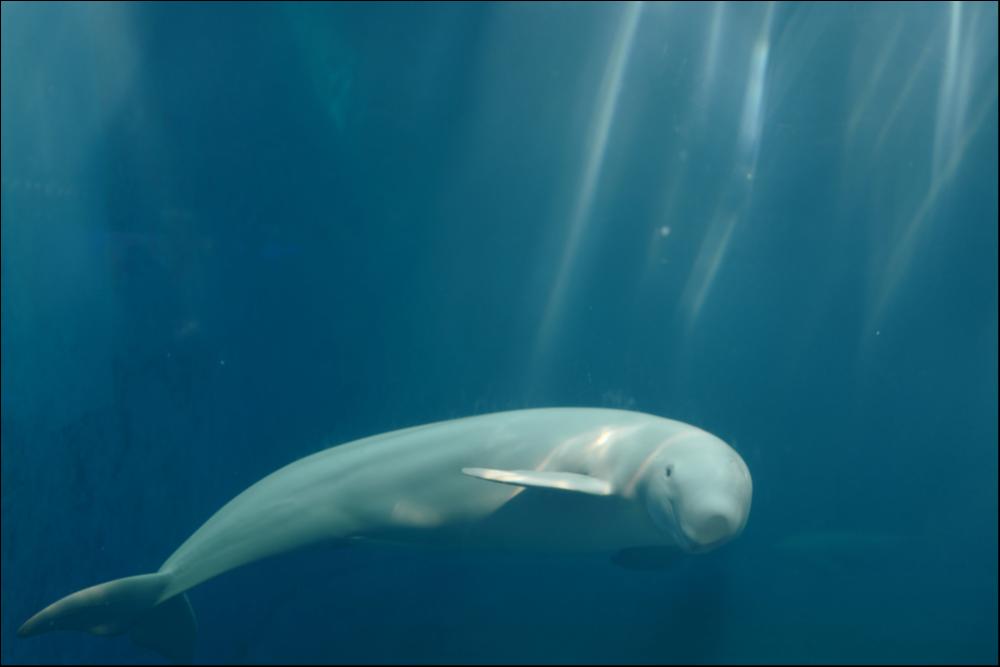
Habitat
The seven species of porpoise have a range of habitats around the world. In the region of the North Atlantic Ocean, they are found near West Greenland to Cape Hatteras. In the North Pacific Ocean, their range goes from near Japan to the Chukchi Sea. They also swim in the Barents Sea toward the coast of western Africa and can also be found in the Beaufort Sea.
Porpoises live in rivers, fjords, estuaries, and bays. Though they do usually go out into the ocean to dive and hunt for prey, porpoises usually stay in water that is 500 feet deep or less. In short, they are known for swimming near coastlines.
Porpoises migrate to different parts of coastal regions. For instance, they may move to a different area of a river or bay to find another source of food.
Additionally, some porpoises migrate at the change of the season. For example, some Harbor porpoises spend the summer in the Gulf of Maine and migrate to the North Carolina coastline for the winter months.
Diet
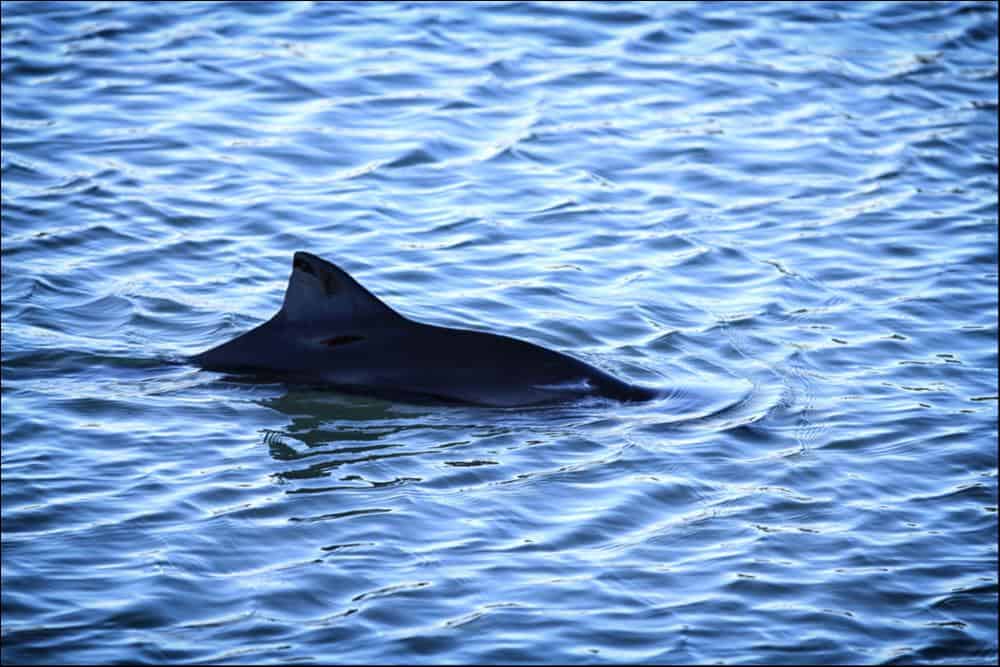
Harbor Porpoises eat around 10 lbs of food each day.
©Mark Caunt/Shutterstock.com
Porpoises are carnivores and eat a variety of fish such as herring, cod, and pollack. They also eat octopus, squid, and sometimes crabs.
Since a porpoise swallows its food whole, there are some items that are harmful for them to ingest. Like a flatfish – when a porpoise tries to swallow this type of fish it can choke to death. Flatfish are large, wide, and not easily swallowed, unlike many other types of fish hunted by porpoises. Most porpoises know by instinct that they shouldn’t eat a flatfish because of the danger it presents to them.
Porpoises eat around 7 to 30 pounds of food per day, depending on the species and size. The harbor porpoise eats about 10 pounds of food each day, equal to close to 10 percent of its body weight. While the Dall porpoise usually eats about 28-30 pounds of food daily. Eating this much food helps them to have the energy they need to swim through the ocean at top speeds.
Scientists believe that when a member of a shoal of porpoises finds prey it lets the other members of the group know about it. This method makes hunting for a meal a lot easier for these incredible creatures.
Predators And Threats
The top predators of the porpoise are great white sharks, orcas, and dolphins. Great whites and orcas have strong jaws and are able to easily overcome a porpoise. Dolphins are fast swimmers and are known to attack porpoises on occasion, although it is unclear why they have this aggression towards them.
Porpoises also run the risk of becoming tangled in commercial fisherman’s nets where they can be injured or die. They may swim into them while chasing prey or simply swim into one accidentally. Another human-based threat to porpoises is water pollution. Chemicals and plastics are harmful if ingested by porpoises, making them very ill or resulting in death.
As porpoises live in coastal areas, they are subject to a lot of noise from boats, ships, and other watercraft. The noise echoing underwater can interfere with the porpoises’ way of communicating and harm their hearing. Therefore, noise pollution is also a threat to the existence of these mammals.
Reproduction, Babies, And Lifespan
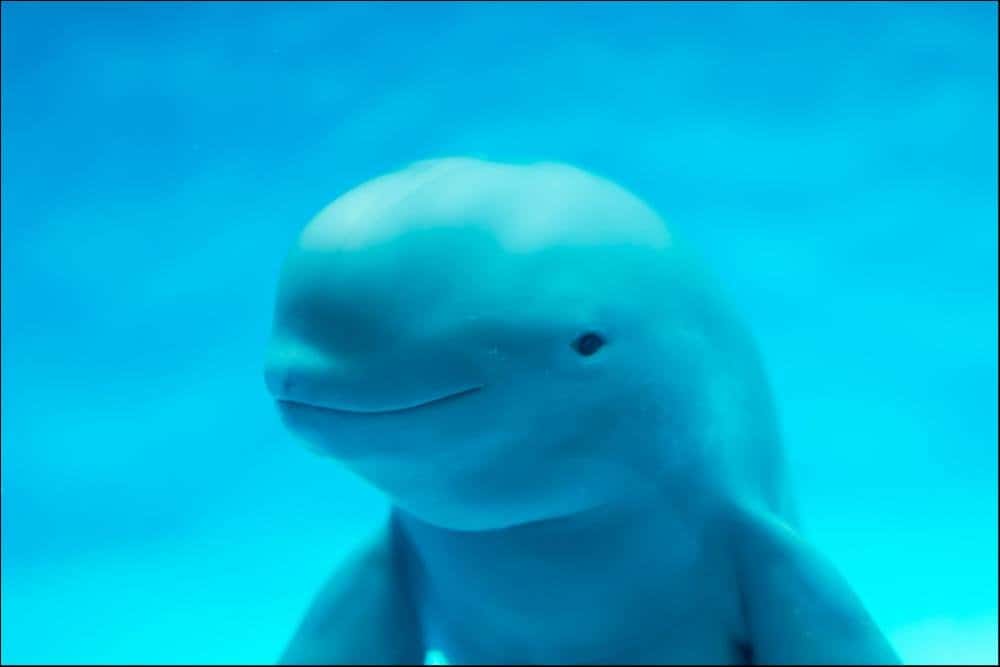
Mating generally occurs more frequently in the spring and fall seasons.
©BlackRabbit3/Shutterstock.com
Porpoises mate throughout the year, but scientists have found more mating activity occurs in the spring and fall seasons. This holds true for dolphins as well.
Male porpoises mate with several females each year. However, a female only has young every two to three years. The gestation period of a female porpoise is 10 to 11 months.
A female porpoise gives live birth to one baby also known as a calf or pup. She gives birth as she swims through the water and sometimes the birth can take two hours. The porpoise calf comes out tail first. After it is born, the calf stays with its mother and nurses as they both swim along. The father is not involved in caring for the baby.
A porpoise calf is nursed for about eight months and slowly learns how to capture fish during this time. It is fully weaned by about 24 months of age.
There is a special relationship between a mother porpoise and her calf. The calf may stay with her from three to six years as it learns how to become a strong swimmer and survive on its own. The process of learning to stay afloat and swim after prey isn’t easy, so a calf needs a lot of guidance from its mother.
Porpoises can live for up to 23 years. The overall health and strength of a porpoise as well as the number of predators in the area can have an effect on its lifespan.
Population
Least concern is the official conservation status of the Harbor porpoise, Dall’s porpoise, and the Spectacled Porpoise, according to the International Union for the Conservation of Nature. While unknown, the harbor porpoise and Dall’s porpoise have the most abundant populations, with one million or more of each species estimated in the world.
Burmeister’s porpoise conservation status is currently listed as near threatened and the narrow-ridged finless porpoise is endangered. Some species are constrained or lowering in certain areas, like the narrow-ridged finless porpoise. In the Yangtze River, its numbers are presently about 1,000 and still decreasing and the populace of the Indo-Pacific finless found off the coast of Hong Kong is around 200.
The most endangered porpoise, and marine mammal, in the world, is the vaquita with a status of critically endangered. There are thought to be less than 19 vaquita porpoises left in the world and they are only located in the Gulf of California. Unfortunately, their population is still decreasing. Due to boat accidents and pollution, numerous vaquitas are killed each year, according to the IUCN.
View all 104 animals that start with HHarbor Porpoise FAQs (Frequently Asked Questions)
What is a porpoise?
A porpoise is a mammal that lives in coastal waters including rivers, bays, and estuaries. It breathes through lungs, gives live birth to pups, and can swim up to 34 mph.
What is the difference between a porpoise and a dolphin?
Looking at a photo of a porpoise and a dolphin, you may think you’re looking at the same animal. But there are differences between them.
For one, dolphins are larger than porpoises. A dolphin’s body is slender and long while a porpoise has a body that is thicker and more stocky. Also, while porpoises have spade-shaped teeth, dolphins have teeth shaped like cones. The dorsal fin on the back of a porpoise looks like a triangle while the tip of a dolphin’s dorsal fin hooks backward.
Finally, a dolphin has a beak-like nose while a porpoise has a rounded head and shorter nose.
Are porpoises omnivores, carnivores, or herbivores?
Porpoises are carnivores eating crustaceans, fish, squid, and octopus. They swallow their food whole instead of chewing it.
Are porpoises dangerous?
Porpoises are not dangerous unless you’re a fish swimming in the ocean! They are social with one another, but try to avoid humans.
Is a porpoise a fish?
No, a porpoise is not a fish. Porpoises are warm-blooded mammals. It’s true that porpoises live in the ocean, but they don’t breathe through gills like fish do. Porpoises have lungs that must take in oxygen.
What Kingdom do Porpoises belong to?
Porpoises belong to the Kingdom Animalia.
What phylum do Porpoises belong to?
Porpoises belong to the phylum Chordata.
What class do Porpoises belong to?
Porpoises belong to the class Mammalia.
What family do Porpoises belong to?
Porpoises belong to the family Phocoenidae.
What order do Porpoises belong to?
Porpoises belong to the order Artiodactyla.
Where do Porpoises live?
Porpoises live off the coasts of Alaska, the eastern United States, Greenland, western Africa, and western Europe.
In what type of habitat do Porpoises live?
Porpoises live in bays, estuaries, oceans, harbors, fjords, and rivers.
What are some predators of Porpoises?
Predators of Porpoises include orcas, large sharks, and dolphins.
What is the average litter size for a Porpoise?
The average litter size for a Porpoise is 1.
What is an interesting fact about Porpoises?
Porpoises are surprisingly not dolphins!
What is a baby Porpoise called?
A baby Porpoise is called a pup or calf.
What is the biggest threat to the Porpoise?
The biggest threats to Porpoises are commercial fishing nets, water pollution, and noise pollution.
What is another name for the Porpoise?
The Porpoise is also called the puffin pig.
How many Porpoises are left in the world?
There are 840,000 Porpoises left in the world.
How fast is a Porpoise?
A Porpoise can travel at speeds of up to 34 miles per hour.
What are the differences between a porpoise and a Beluga whale?
The biggest differences between a porpoise and a beluga whale are their size, morphology, and range.
Thank you for reading! Have some feedback for us? Contact the AZ Animals editorial team.

